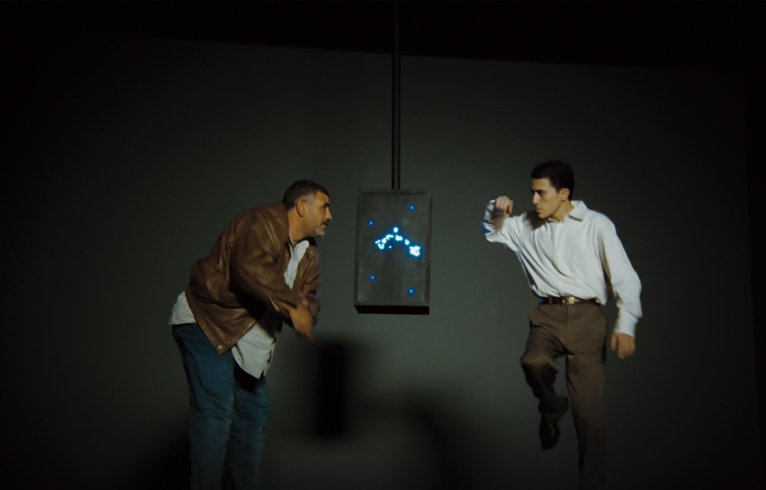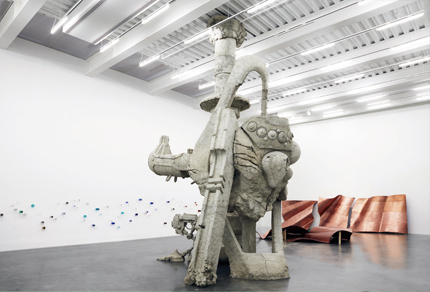THE UNGOVERNABLES: 2012 NEW MUSEUM TRIENNIAL
| May 4, 2012 | Post In LEAP 14

They say a picture is worth a thousand words. At the New Museum’s second Triennial “The Ungovernables,” however, visitors often find themselves needing to trudge through lengthy, jargonistic labels in order to make sense of the many artworks and projects on display. While this seems to have become the norm these days for contemporary art exhibitions worldwide— the art therein unanimously packed with interdisciplinary approaches, institutional and ideological critiques, and multivalent references— it is a trend that sometimes muddles those thousand words into a thousand ambiguities.
Ambitiously titled in the wake of recent political upheavals and economic crises, most prominently the Occupy Movement, the Triennial features 34 international artists and collectives from a generation now in their late twenties and thirties; the majority of these participants have never exhibited in the U.S. before, though many, including Adrián Villar Rojas, Hassan Khan, and Danh Võ, are already international biennial veterans. Curator Eungie Joo intends for the show to “embrace the energy of that generation’s urgencies,” but the line-up proved to be anything but mutinous, artistically or politically.
Working your way down from the top floor, one first encounters a cube of bank notes stacked Carl Andre-style on the floor. The label informs that it results from Bangkok-based artist Pratchaya Phinthong’s repeated trading of his five thousand euros investment into Zimbabwean dollars— one of the world’s weakest currencies— thereby echoing the Asian financial crisis of 1997 and transforming banknotes into “art commodity.” Ready-made, performative in process, and laden with critical gestures, the work, like many others in the show, leaves little room for alternative interpretations. The art object within the institution’s walls seems merely residual, an illustration of or footnote to a lengthier endeavor that often takes the form of an explorative intervention, which in turn appears to be somewhat derivative of the popular critical theories— neo-colonialism, relational aesthetics, identity politics, and so on— that underscore the art world’s new orthodoxy.
At the innermost corner of the fifth floor gallery, the transgender Asian American artist Wu Tsang stares squarely into the camera and mechanically recites a text from autism rights activist Amanda Baggs. The performance is nuanced and interpretive of the excerpt itself (thanks to Wu’s theory-teaching background), but the artist’s rapid ascension to stardom (this year double-casting in the New Museum Triennial and the Whitney Biennial, for one) is equally telling and ironic. While minority groups in the real world endure and fight implicit prejudices, artists who play the minority card in the art world prevail, because multiple “otherness,” among many things, is just what every mainstream art institution is dying to include in group shows. To balance out, to be politically correct, and towards cliché.
In line with the timeliness implied in the title, many artworks and projects reflect recent political and economic issues. In her 2008 work The Trainee, Finnish artist Pilvi Takala pulled an impressive month-long “occupation” of an accounting firm’s office where she was temporarily employed, doing nothing but sitting still and spacing out. The multi-channel installation at the triennial loosely simulates an office setting and streams recordings of both her performative intervention and her colleagues’ responses. As a quiet, individualized subversion of the corporate world, it nevertheless gives the impression of merely dwelling on the surface; in terms of evoking the numbing daily routines of white-collar life, TV series such as The Office might provide more insightful satire and drier wit.

Showcasing thin, segmented copper replicas of the Statue of Liberty scattered about in a Richard Serra-esque manner in his 2011 work We the People, Vietnamese artist Danh Võ touches upon problems of labor inherent in global capitalism (the pieces were intentionally produced in a workshop in China) but acquiesces to an all-too familiar deconstructive stance. The Propeller’s Group, based in Ho Chi Minh City and Los Angeles, explores ideological problems from a more interesting perspective. Following their instructions to re-brand Communism, a generic advertisement agency produced a whimsical animated video that light-heartedly sells the idea of “New Communism.” Next to the final product, a five-channel synchronized video installation shows the discussions in progress. This and many of the other works call to mind curator Hou Hanru’s recent correspondence with Hans Ulrich Obrist, in which he discusses and cautions against “political exoticism and consumption of the other” endemic to recent creative practices.
Works less concerned with theoretical appendages, on the other hand, often turn out more appealing and cliché-free. These include Brazilian artists Cinthia Marcelle and Tiago Mata Machado’s 2011 video The Century, which looks down to a dingy street gradually littered with all sorts of debris, buckets, and tubes in recurring, rhythmic crashing sounds that concisely yet poetically echoing the latest happenings. Or Argentinian artist Adrian Villar Rojas’ towering, cracked clay sculpture reminiscent of an abandoned mechanical structure— titled A Person Loved Me, its imposing presence transforms the gallery into a dystopian terrain with the romantic evocations of a post-apocalyptic world often imagined in sci-fi novels and manga. Or fellow Argentinian Mariana Telleria’s Días en que todo es verdad (Days of Truth), a Wunderkammer of found and manipulated objects— such as a barren branch whose twigs crawl into an array of white porcelain cups of various shapes and sizes— neatly displayed on wood shelves.
On the second floor is Cairo-based artist Hassan Khan’s traffic-stopping 2010 video JEWEL. Accompanied by highly-contagious Shaabi (a popular Cairene genre fusing traditional instruments and electronic music) score composed by the artist himself, the video begins with closeup shots of a glittering anglerfish later revealed to be a neon-blue image on a slowly revolving square disco ball. As the camera slowly zooms out, we see two figures, one pudgy middle-aged man in a leather jacket and jeans, the other a slender young lad in a white shirt and khakis dancing in the unlikely setting of a black box. The camera draws further away as the two men spontaneously change moves, interacting in a seemingly endless dance, the perpetual space between them a poignant metaphor for the inexplicable subtleties in relationships of every nature. Inspired by the actual interaction and class and power struggles witnessed in real life, the work is charged with intense, seductive and mind-boggling energies that leave many viewers mesmerized and slightly bubbly.
The predominance of video, installation, and other multimedia work makes the inclusion of one set of expressive, academic-looking oil paintings portraying Africans by London-based artist Lynette Yiadom-Boakye’s appear tokenistic. The small number of drawings and murals on display appear somewhat mediocre, excepting Hong Kong artist Lee Kit’s pastel-blue cardboard paintings of selected merchandise logos that posses personal significance to the artist seen in his self-effacing installation Scratching the Table Surface and Something More.
Overall, the Triennial is a clustering of different directions and agendas, where familiar formulas of institutional critique, identity politics, and social activism (however well-intentioned the initiative) still plague the creative impulses in many of the works. Operating beyond this latest form of institutionalization and exploring more meaningful engagements will continue to be a challenge to artists of this generation, and to those who come after. Referencing her country’s former military dictatorship, London-based Argentinian artist Amalia Pica’s Venn Diagrams— two overlapping circles projected on the wall— prompt reflection on yet another complicated matter: as contemporary art relentlessly pushes its boundaries to embrace broader issues and intersect with other disciplines— sometimes producing hybrids that are essentially mature products of the other disciplines, be they theater (a hotly-debated topic in last year’s Performa), political science research projects, or anarchist movements— where is the fine line between all-encompassing and over-diluted? And what is an art institution’s place in all this?
Maybe some answers are to be found in the next Triennial. Wang Xin


